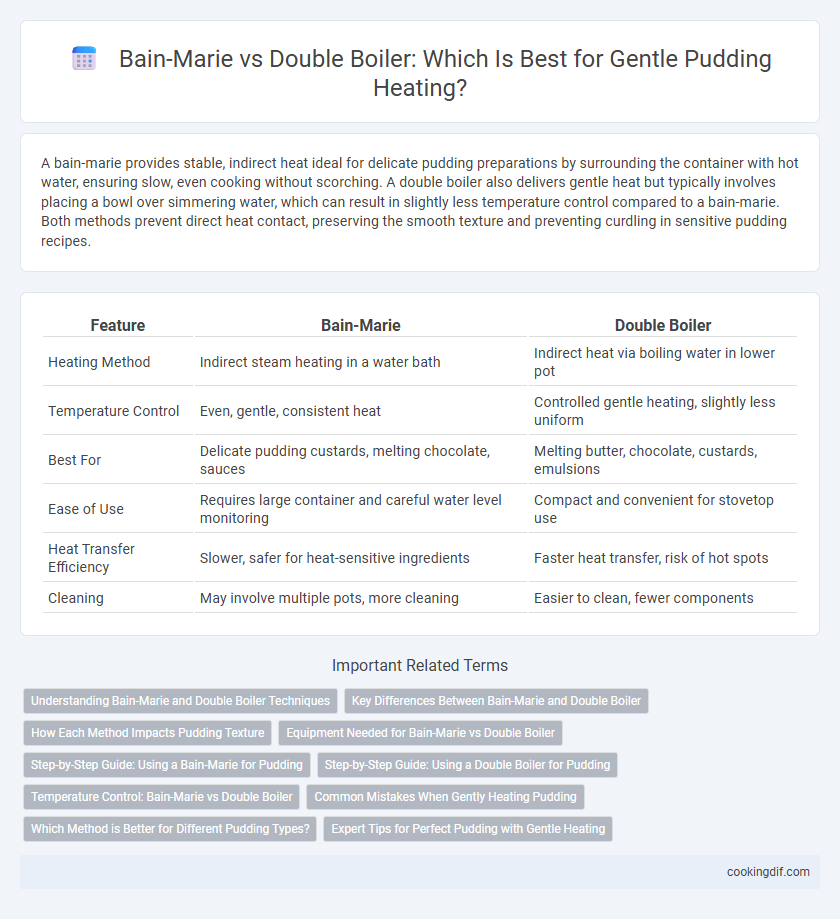A bain-marie provides stable, indirect heat ideal for delicate pudding preparations by surrounding the container with hot water, ensuring slow, even cooking without scorching. A double boiler also delivers gentle heat but typically involves placing a bowl over simmering water, which can result in slightly less temperature control compared to a bain-marie. Both methods prevent direct heat contact, preserving the smooth texture and preventing curdling in sensitive pudding recipes.
Table of Comparison
| Feature | Bain-Marie | Double Boiler |
|---|---|---|
| Heating Method | Indirect steam heating in a water bath | Indirect heat via boiling water in lower pot |
| Temperature Control | Even, gentle, consistent heat | Controlled gentle heating, slightly less uniform |
| Best For | Delicate pudding custards, melting chocolate, sauces | Melting butter, chocolate, custards, emulsions |
| Ease of Use | Requires large container and careful water level monitoring | Compact and convenient for stovetop use |
| Heat Transfer Efficiency | Slower, safer for heat-sensitive ingredients | Faster heat transfer, risk of hot spots |
| Cleaning | May involve multiple pots, more cleaning | Easier to clean, fewer components |
Understanding Bain-Marie and Double Boiler Techniques
Bain-marie and double boiler techniques provide gentle, indirect heat essential for delicate pudding preparation, preventing curdling or burning. A bain-marie involves placing the pudding container in a water-filled pan, ensuring uniform heat distribution and moisture retention during cooking. The double boiler uses steam from boiling water beneath a smaller pot, allowing precise temperature control crucial for smooth, creamy pudding textures.
Key Differences Between Bain-Marie and Double Boiler
A bain-marie uses a water bath to surround the container holding the pudding mixture, ensuring even and gentle heat distribution without direct contact with the heat source. A double boiler consists of two stacked pots, where the lower pot holds simmering water that indirectly heats the upper pot with the pudding, providing controlled temperature and preventing scorching. Key differences include the bain-marie's ability to maintain consistent, low heat ideal for delicate custards, while the double boiler allows more direct heat transfer, making it slightly faster but requiring close monitoring to avoid overheating.
How Each Method Impacts Pudding Texture
Using a bain-marie provides even, consistent heat by immersing the pudding container in hot water, which prevents curdling and results in a smooth, creamy texture. A double boiler uses indirect heat from steam between two pots, allowing precise temperature control but may risk uneven heating if not monitored closely, potentially causing lumps. Both methods enhance pudding texture by minimizing direct heat exposure, but the bain-marie is generally preferred for its stability and uniform heat distribution.
Equipment Needed for Bain-Marie vs Double Boiler
A bain-marie requires a deep, heatproof container placed in a larger pan filled with simmering water, while a double boiler consists of two stacked pots with steam gently heating the upper pot containing the pudding mixture. The bain-marie setup often involves an oven-safe dish and a roasting pan or similar vessel, making it suitable for even, slow cooking in the oven. In contrast, a double boiler setup is typically used on the stovetop with a dedicated two-piece cookware set designed to prevent direct heat contact and control temperature precisely.
Step-by-Step Guide: Using a Bain-Marie for Pudding
Place the pudding mixture into a heatproof bowl and set it over a pot of simmering water, ensuring the bowl does not touch the water to prevent direct heat. Stir the pudding continuously to achieve smooth, even cooking without scorching, maintaining a low and steady temperature. This bain-marie technique provides gentle, controlled heat essential for custard-based puddings, ensuring a silky texture and preventing curdling.
Step-by-Step Guide: Using a Double Boiler for Pudding
Using a double boiler for pudding involves filling the bottom pot with simmering water while ensuring the top bowl sits securely without touching the water. Slowly whisk the pudding mixture in the top bowl to maintain a consistent temperature, preventing curdling or burning. This gentle heating method helps achieve a smooth, creamy texture by evenly cooking the pudding through indirect steam heat.
Temperature Control: Bain-Marie vs Double Boiler
A bain-marie offers precise temperature control by surrounding the pudding container with hot water, maintaining consistent heat without direct contact with the heat source. In contrast, a double boiler uses steam heat from boiling water below, which can cause slightly higher temperatures and less uniform heating. This difference makes the bain-marie ideal for delicate puddings requiring gentle, stable heat to prevent curdling or scorching.
Common Mistakes When Gently Heating Pudding
Using a Bain-marie or a double boiler ensures gentle, even heating crucial for delicate puddings, preventing curdling or burning. Common mistakes include overheating the water, which causes uneven heat distribution and risks separating the custard. Avoid direct contact between the pudding mixture and boiling water in a double boiler to maintain smooth texture and consistent temperature control.
Which Method is Better for Different Pudding Types?
Bain-marie provides uniform, gentle heat ideal for delicate puddings like custards and flans, preventing curdling and ensuring smooth texture. Double boilers allow more direct heat control, making them better suited for thicker, starch-based puddings that require gradual cooking without scorching. Choosing between bain-marie and double boiler depends on pudding type, with bain-marie favored for creamy desserts and double boilers for dense, mixture-based puddings.
Expert Tips for Perfect Pudding with Gentle Heating
Using a bain-marie or double boiler ensures gentle, consistent heat crucial for smooth, creamy pudding without curdling or burning. Experts recommend maintaining water at a low simmer and stirring continuously for even heat distribution and preventing lumps. Selecting the right vessel size to avoid direct steam contact enhances texture and flavor in delicate pudding preparations.
Bain-marie vs double boiler for gentle heating Infographic

 cookingdif.com
cookingdif.com